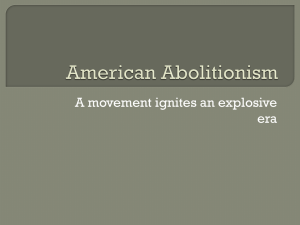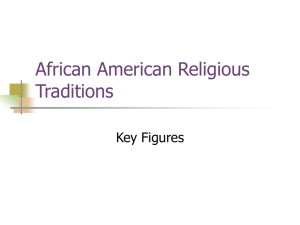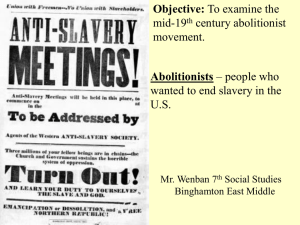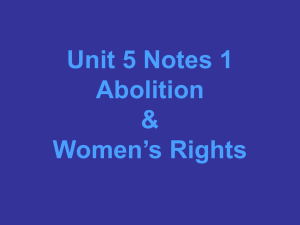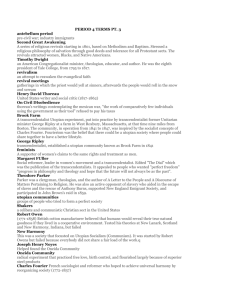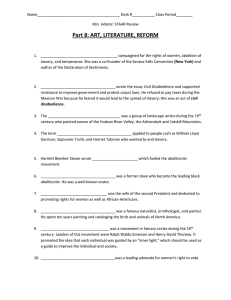Document 14118527
advertisement
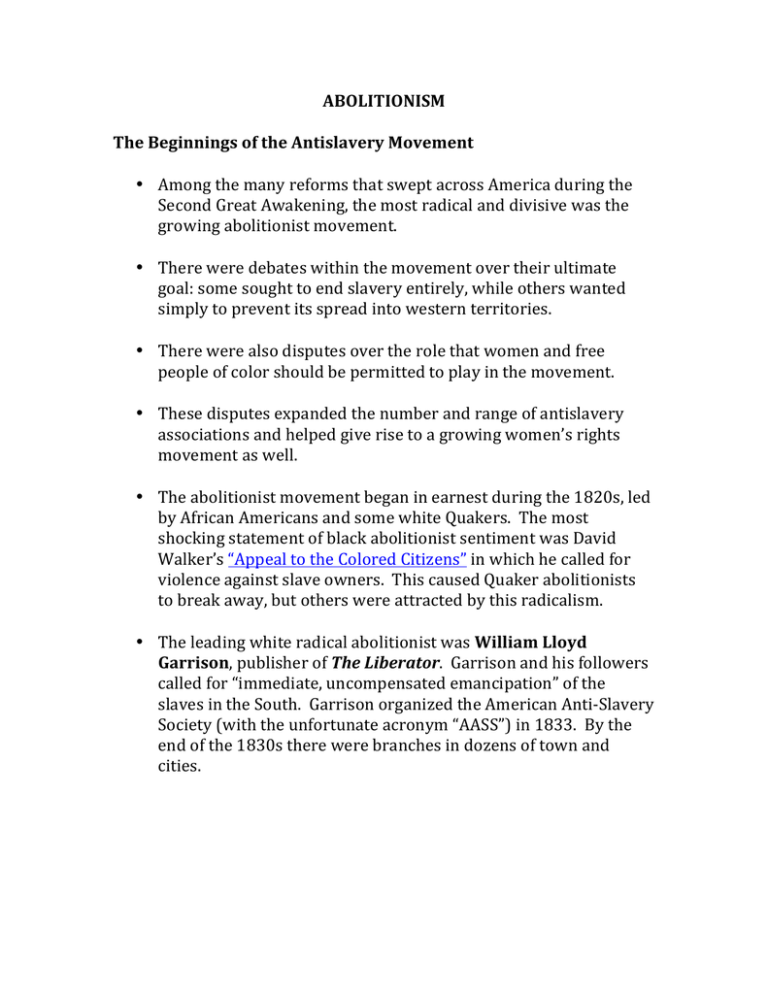
ABOLITIONISM The Beginnings of the Antislavery Movement • Among the many reforms that swept across America during the Second Great Awakening, the most radical and divisive was the growing abolitionist movement. • There were debates within the movement over their ultimate goal: some sought to end slavery entirely, while others wanted simply to prevent its spread into western territories. • There were also disputes over the role that women and free people of color should be permitted to play in the movement. • These disputes expanded the number and range of antislavery associations and helped give rise to a growing women’s rights movement as well. • The abolitionist movement began in earnest during the 1820s, led by African Americans and some white Quakers. The most shocking statement of black abolitionist sentiment was David Walker’s “Appeal to the Colored Citizens” in which he called for violence against slave owners. This caused Quaker abolitionists to break away, but others were attracted by this radicalism. • The leading white radical abolitionist was William Lloyd Garrison, publisher of The Liberator. Garrison and his followers called for “immediate, uncompensated emancipation” of the slaves in the South. Garrison organized the American Anti-­‐Slavery Society (with the unfortunate acronym “AASS”) in 1833. By the end of the 1830s there were branches in dozens of town and cities. William Lloyd Garrison • Many of Garrison’s followers were also active in the underground railroad, a secret network of safe-­‐houses which assisted runaway slaves escaping to freedom. • One of the most powerful abolitionist speakers and authors, and a strong ally of Garrison, was Frederick Douglass whose autobiography became a best seller and who was a sought after speaker and important fundraiser for the cause of abolitionism. Frederick Douglass Abolitionism and Women’s Rights • Women played a prominent role in the abolitionist movement, including the Grimke sisters (Sarah and Angelina), daughters of a S.C. planter who moved to Philadelphia, converted to Quakerism, and became active first in the abolitionist movement and then became leading women’s rights activists. • The role of women was very controversial among leaders of the abolitionist movement, some of whom (including Rev. Finney) criticized abolitionist activism as being “outside women’s sphere.” Angelina and Sarah Grimke • Ultimately, women who started out in the abolitionist movement decided to focus more exclusively on women’s rights. Lucretia Mott, Elizabeth Cady Stanton and others organized the Seneca Falls Convention in July 1848 in upstate New York. Here, Frederick Douglass spoke and the delegates signed a Declaration of Rights and Sentiments, modeled on the Declaration of Independence, calling for equal rights for women. The Rise of Antislavery Parties • In response to the rising tide of abolitionism, in 1840 the Liberty Party was formed. In the election of 1844, despite winning just 2% of the vote, the Liberty Party drew enough votes away from Henry Clay to ensure the victory of James K. Polk. • In 1848, the Liberty Party became part of a larger coalition, joining with antislavery Whigs and northern Democrats, along with African American leaders like Frederick Douglass, to form the Free-­‐Soil Party. • The Free-­‐Soil Party, focused not so much on abolishing slavery in the South as on stopping the spread of slavery, nominated Martin Van Buren as its candidate in 1848—and won 10% of the popular vote. The popularity of the Free-­‐Soil Party showed that the controversy over slavery could no longer be ignored by the two major parties.
